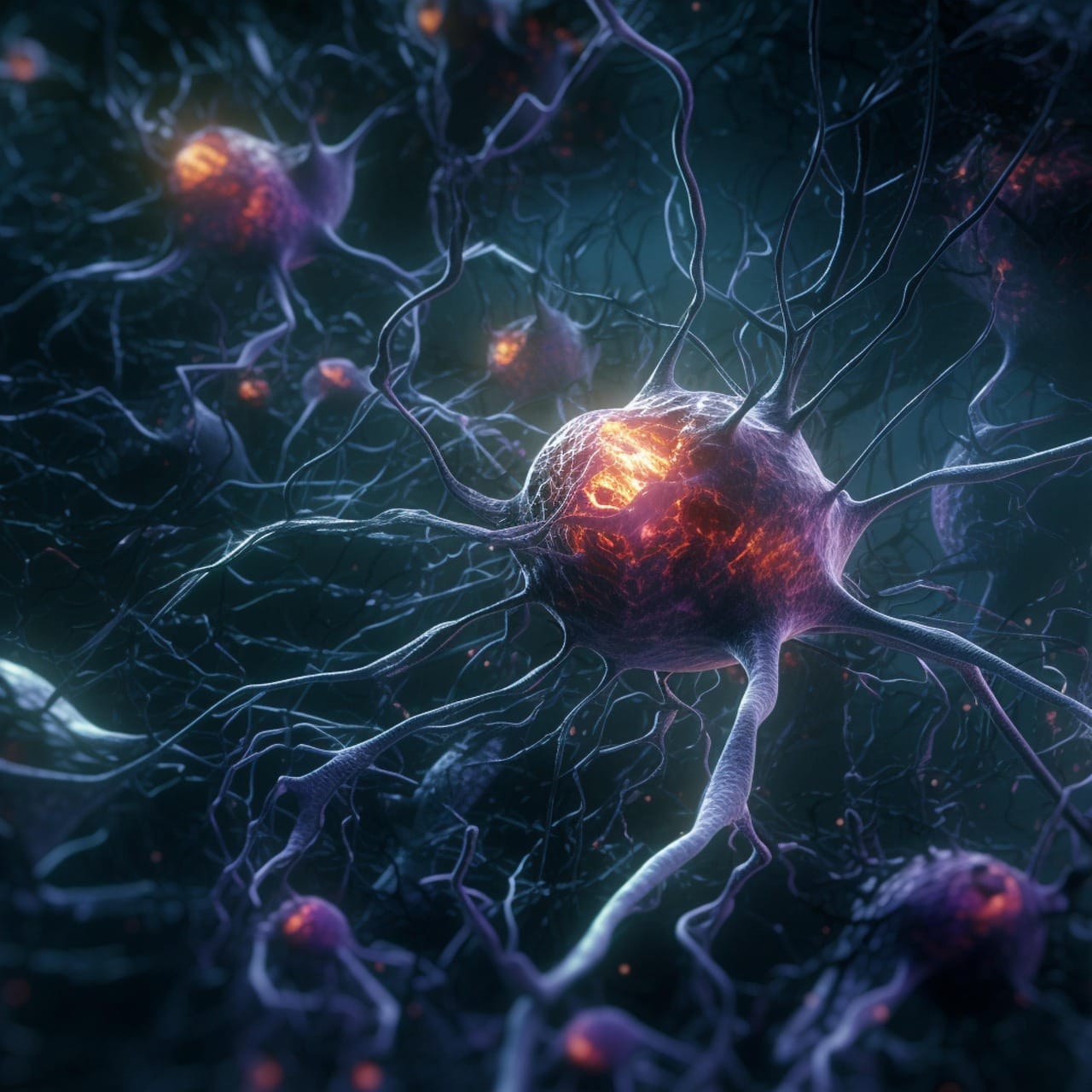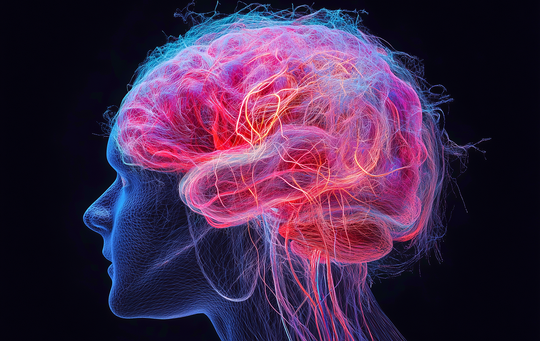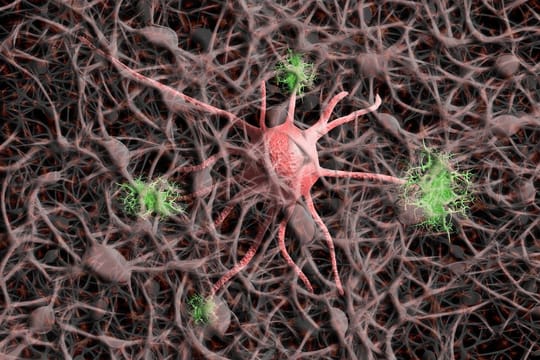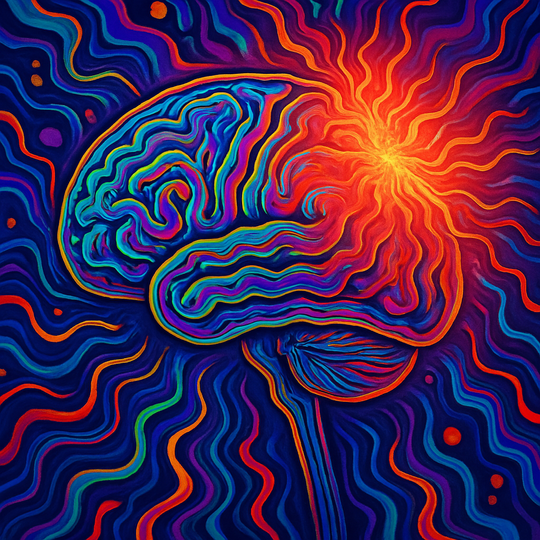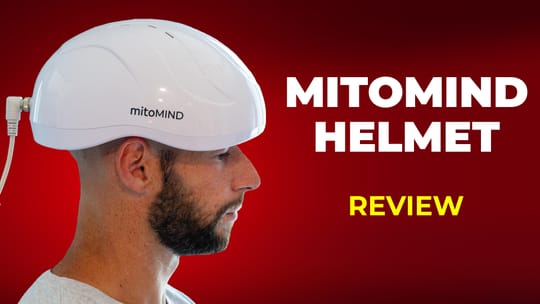Tinnitus. You may have heard about it, but do not know what it means. Tinnitus is an unrelenting noise that's invisible and inaudible to others, disrupting life in ways few people understand!
Imagine having a conversation, but there's a constant noise in the background that disrupts the words. Sleep may also become a struggle for you, as you'd have continuous noise in the background that counters your peace at night. And maybe you've got problems finding relaxation during social activities.
So if you live with tinnitus, it’s not just a sound—it’s a battle against isolation and despair. There's good news, too, however! In this article, I explore all the published science on red light therapy for tinnitus. And, fortunately, science is hopeful enough that I recommend anyone with tinnitus to try this treatment.
If you're short on time, I at least recommend you read my summary below. If you want to understand my full argument, however, then read the entire article where I go into tons of detail! I also give you advice on how to treat your tinnitius with red light therapy below!
Let's go - and help you with that continous noise issue:
Tinnitus, a persistent ringing of the ears, affects a whopping 740 million worldwide! Tinnitus is mainly considered a symptom, and has a significant impact on your quality of life if you're affected. That tinnitus can be caused by tons of different factors, such as noise, hearing loss, stress, ear infections, and medications, and is also linked to inflammation, anxiety, and depression.
The good news here is that red light therapy is a very good candidate to try for tinnitus symptoms. In terms of tinnitus, red light therapy lowers inflammation, enhances blood flow, and helps heal the auditory organs inside the ear.
Many different studies have investigated red light therapy for tinnitus, and direct treatment with light inside the ear canal has the best profile right now. Not all studies are positive, though. Some studies, however, show 60-75% reductions in symptoms, which is life-changing if you've got tinnitus!
Also, the studies with positive outcomes show benefits such as reduced tinnitus severity, decreased loudness of the tinnitus, and enhanced quality of life. More research is needed here, but wavelength, treatment methodology (such as inside the ear or on top of the ear), and dose may all affect the outcome. Hopefully, we'll see more research here in the coming years and decades!
You only need very low doses of 2 - 4 J/cm2 for the best effect for treatment inside the ear canal. Over time, you can increase the dose to 10 J/cm2 max. If you do treat the ears, you may require higher doses so that more light penetrates. For now, I recommend the LightpathLED torch (discount code ALEX saves here) with the "oral attachment" to directly treat the cochlear organ inside the ear and adjacent tissues. Side effects are infrequent here, but I recommend you monitor your results.
Overall, red light therapy for tinnitus is very promising. Hopefully, we see more research emerge to better understand what makes a successful red light therapy for tinnitus treatment, as opposed to treatments that yield no effect.
If you need an introduction to what these terms mean, check the following resources:
- What Is Red Light Therapy?
- Red Light Therapy Explained: Basic Terms Guide
- Start Here - Light Therapy 101 & Buyers Guide
- Red Light Therapy Dosing Chart: The Raw Data From Hundreds Of Studies
- Red Light Therapy Dosing: Why It's Complicated!
- Red Light Therapy Wavelengths Benefits: The Ultimate Guide
- How Often Should You Use Red Light Therapy Explained
These resources should give you a basic understanding of how red light therapy works, and the discussions around it!
What Is Tinnitus?
First, I'll explore the best recent scientific evidence on tinnitus. For that goal, I'll use the most recent "reviews", which analyze and integrate earlier scientific publications on a topic. I've only picked reviews from the last five years to ensure we're discussing the latest evidence on this topic.
But first things first:
Tinnitus As Both A Symptom And A Disease
What is tinnitus anyway? Well, with tinnitus, you've got a noise or ringing in your ears even though no external sound is generated. The tinnitus is often described as ringing, buzzing, hissing, or clicking - so different sounds are possible.
Officially, tinnitus is a symptom and not a disease by itself. However, for a small part of the human population, you can argue that tinnitus is a disease because their lives are strongly affected.
Biological Causes Of Tinnitus
Different causes of tinnitus exist. Examples are ear infections, exposure to loud noise over time, plain and simple hearing loss, and pharmaceuticals. So there's not a single cause of tinnitus. Different biological pathways can cause tinnitus - a review states on this topic that:
"Multiple pathophysiology were identified, including inner ear pathology, auditory nerve synchronisation, central nervous system anomalies and limbic and autonomous nervous system problems. The group of papers evaluated tinnitus patients with specific diagnostic tests such as pure tone audiometry, Immitance audiometry, otoacoustic emission, Auditory brainstem response and diagnostic imaging of fMRI, MRI and PET study." (1)
So, one biological cause of tinnitus isn't the same as another biological cause of tinnitus (1). Nevertheless, stress seems to be one primary cause of tinnitus, even if the stress is just psychological (2). Stress is not always a cause of tinnitus, however, but only in some cases (6)
Hearing loss as a result of loud music is a non-psychological stressor, here (3). Nevertheless, in most cases, the cause of tinnitus cannot be identified (4). Doctors will nonetheless ask you about lots of different causes because it makes the tinnitus more treatable in some cases (4).
Such potential tinnitus causes include:
- Damage to the ear, specifically the hair cells, leads to lower sound input to the brain. The brain then compensates by creating tinnitus.
- Other biological dysfunctions may exist as well, such as those caused by infections or pressure imbalance.
- Sensitization of the auditory pathways of the brain, so that a normal sound impulses are received differently in the brain.
- Neck or jaw issues that affect the auditory pathways.
- Damage caused by taking pharmaceuticals that damage ear structures.
- Blood flow problems around the ear.
- Neurological conditions.
And, of course, stress and anxiety! Recent reviews also show that tinnitus is strongly linked to chronic inflammation (5). That's a big hint for your and me as we'll see that red light therapy can have a huge effect on chronic inflammation!
Tinnitus is also linked to other health conditions such as depression, anxiety, very sensitive hearing of everyday sounds (hyperacusis), and even aging (7). Genetics also plays a role as European and Asian populations are at higher risk (8).
The Many Tinnitus Risk Factors
A whopping 740 million people are affected by tinnitus worldwide (9). Tinnitus risk generally grows with age (10). That's a sign as well, as the earlier inflammation link, as there are tons of effects of aging that make your physiology less effective.
Smoking and obesity are two main tinnitus risk factors (11). And alcohol and caffeine intake aren't established risk factors (11). Then, depending on the type of tinnitus you're affected by, your heart and blood vessel, neurological, and psychological health play a role (12). A healthy diet may also avert tinnitus risk (12).
Loud noise exposure - naturally - is a risk factor, especially if you're young (13). This is the tinnitus caused by going to loud concerts, for instance. Overall hearing loss is also a risk factor, but that one is different as hearing loss usually progresses with age (14). And because hearing loss is a risk factor, aging automatically is a risk factor as well (14). Of course, loud noise and hearing loss are also interrelated, which explains the dynamics in more detail.
There's a lot of discussion about risk factors in this field, however, as some reviews about my picture above disagree (15; 16; 17; 25). Some other risk factors are cancer treatment, for instance, but that isn't applicable for most humans (16; 17). Hopefully, you've got a better understanding of how, however!
What It’s Like Living With Tinnitus? Quality Of Life Issues
Tinnitus has a considerable cost to both individuals and society (18). Of the 10% of the world's population that is more or less affected, 1-2% have a lower quality of life (18; 19). Tinnitus treatment cost is also high (18). The problem here is that there's no cure available in most cases (19).
So, many people who have their quality of life affected have to live with tinnitus for decades on end. Tinnitus - once it affects quality of life - often affects sleep quality as well, leading to insomnia (20). And insomnia, in turn, can set you up for many other health problems - ranging from heart and blood vessel disease to diabetes, neurodegeneration, poorer organ function, and more. So, people for whom the tinnitus becomes more than a nuisance, their overall health will also be influenced!
One risk here is that people with severe tinnitus start to lose hope in their lives as well (21). As a result, you may have anxiety around bedtime with tinnitus, for instance. And you may be unable to fall asleep again after waking at night, because it's really quiet.
The tinnitus can also cause emotional distress and difficulty focusing during the day. Through these mechanisms, your ability to perform at work may be affected, which then leads to a lower quality of life again. You may also have mental fatigue and a perceived loss of control when it's always present, while you need to focus.
Also, if you've got tinnitus, it may be hard to communicate with others without the condition as there's no universal biological cause. Some people may believe that tinnitus is entirely psychological, for instance.
Current Tinnitus Treatment: An Imperfect Solution
Many different tinnitus treatment options exist, but as stated before, these don't fully cure the condition! Medications are used for tinnitus, for instance, but don't fix the underlying issue (22). Other medications can also cause problems. Here's what researchers write about that dynamic:
"In addition, medicines used to treat other diseases, as well as foods and other ingested materials, can result in unwanted tinnitus. These include alcohol, antineoplastic chemotherapeutic agents and heavy metals, antimetabolites, antitumor agents, antibiotics, caffeine, cocaine, marijuana, nonnarcotic analgesics and antipyretics, ototoxic antibiotics and diuretics, oral contraceptives, quinine and chloroquine, and salicylates." (22).
A lot of varying pharmaceuticals are prescribed for tinnitus, but none have currently been approved in the US (23). The problem is that multiple medications are often necessary to cover all biological pathways (23). Also, tolerance and side effects of medication may occur over time, so it's not a perfect solution.
Other methods to treat tinnitus include focusing on the risk factors mentioned before, such as smoking. Relaxation methods such as mindfulness and other stress-relief techniques can also work.
Then there are hearing aids and auditory retraining (24). The goal here is to deal with the auditory causes of tinnitus directly. White noise that masks the silence is an example.
There are lots of experimental therapy used as well, such as vagus nerve stimulation for improving relaxation (26). Neuromodulation and neurofeedback are other examples here - such techniques are popular in the biohacking space (27; 28). But, as you know, there's no fix right now so it's more like hit or miss with these strategies!
Hence, you and I need better options for treating tinnitus. That's where red light therapy potentially comes in! I'll explore these dynamics below in great detail:
From Ancient Sunlight To Modern LEDs
I've written about the topic of light and brain health extensively in my Red light Thearpy For Upgrading Your Brain Health. Light therapy has been used for centuries though. But lately, light therapy has been more extensively used for brain-related issues.
Let's take a step back, however:
Light therapy and sunlight exposure have a history as old as human civilization (29; 30; 31; 32; 33; 34). With the discovery of the light bulb, it became possible for humans to use light therapy through other means than sunlight and fire.
That dynamic developed a lot throughout the 20th century, mostly. At first, lamps created vitamin D and counter diseases such as rickets and tuberculosis. Then, in 1969, what is today called "photobiomodulation" or "red light therapy" was discovered (35; 36).
These first red light therapy studies were focused on wound healing. But soon, researchers found out that light therapy can help with tons of different goals, such as joint pain, skin rejuvenation, wellbeing, organ function, exercise performance and recovery, and much more!
In the last few decades, there have also been tons of studies on red light therapy for the brain. I've written loads of articles on this topic, and you can check them here:
- Red Light Therapy For Parkinson's Disease: A Hopeful Strategy!
- Red Light Therapy For Fibromyalgia: Incredible Pain Relief & Much More!
- Red Light Therapy For Upgrading Your Brain Health
- Red Light Therapy For Sleep: The Science of Sweet Dreams
- Red Light Therapy For Neuropathy: The Promising Science
- Does Vielight Work? A Close Look At The Spectacular Vielight Science
- Neuradiant 1070: Red Light Therapy For Your Brain?
- Red Light Therapy For Depression: A Potential Solution
Depending on the condition, red light therapy either has a decent effect or a powerful effect. For neuropathy and Parkinson's disease, for instance, there's an auspicious effect but we need more studies. For fibromyalgia and depression, the currently published science is already awe-inspiring!
But wait:
Today's goal is red light therapy for tinnitus, of course! Fortunately, there are 600 - 700 studies on red light therapy for the brain right now. And, there are more and more studies on tinnitus as well, so let's explore the scientific literature there:
What Science Says About Red Light Therapy And Tinnitus
Vladimir Heiskanen has listed about 35 studies on red light therapy for tinnitus (37). These studies consider different topics such as:
- "Does red light therapy work for tinnitus?"
- "What about red light therapy for ears and the ear region?"
- "How can red light therapy fit inside a holistic approach to tinnitus?"
And so forth! The good thing here is that most studies are human studies here–not based on animals (37). There are a few reviews as well which analyze and integrate earlier evidence on the topic - I'll cover these after considering the human studies:
Human Red Light Therapy For Tinnitus Studies
There are about 30 studies on red light therapy for tinnitus in humans - so that's a huge list of publications!
Here's the outcome of all of these studies, analyzed one by one:
- First, an 830 nm study uses a laser with a good outcome for managing chronic tinnitus (38). This is a TINI laser device, which stands for Transcutaneous Infrared Neural Stimulation (TINI). That laser stimulates nerves around the ear or neck to change your auditory pathways and reduce your tinnitus perception. In this study, the researchers used different questionnaires and other outcome measures, such as:
"The Tinnitus Handicap Inventory (THI), Tinnitus Functional Index (TFI) and Tinnitus Magnitude Index (TMI) were used to assess tinnitus-related outcomes. Psychological assessments were also conducted to measure levels of depression, stress and anxiety."
- These questionnaires are pretty self-evident, as the THI measures the level of handicap in daily life because of tinnitus, the TFI measures the ability to function daily, and the TMI measures how bad the tinnitus is. So, with lower TMI, you'll have less intense tinnitus sound in your daily life. Unfortunately, I can't see many treatment specifics in the study.
- Secondly, another 830 nm study with the same TINI laser device (39). Here, I get more info, saying that the inner ear targets inner ear structures, like the cochlea. The cochlea converts sound waves into electrical signals for the brain. The tinnitus didn't improve in this study, but psychological symptoms and tinnitus symptoms themselves did.
- Here you can see the structures inside the ear that are treated:

- The important thing here is to realize that the tympanic membrane and cochlea are thus treatable with a laser. The TINI laser goes into the ear, but stops before the tympanic membrane (your eardrum!)
- Thirdly, a study uses 650 and 660 nm light with two devices (41). The measured tinnitus level was reduced from 70% to 60-65%, depending on the application method. The Tinnitool at 650 nm goes into the ear as well for stimulation of the inner-ear structures.
- Then, there's a study with many different setups (42). The efficacy of red light therapy for tinnitus isn't apparent here, however. The study used 660 and 660 + 808 nm as a combination. The researchers also mention that more research is needed into the correct wavelength and treatment protocol selection, etc! I'll come back to that topic later.
- Another 660 and 808 nm study doesn't provide a clear treatment protocol description and also doesn't find an effect (43).
- One more study shows that adding physical therapy to red light therapy may have additional benefits (44). I won't go into great detail here as it's not an option most people will likely use consistently.
- An 830 nm study uses the TINI device again with good success (45). Tinnitus duration and loudness decreased in the group receiving light therapy.
- Another study uses "polychromatic light" - with wavelengths of 280 - 1,100 nm at 100 mW/cm2 (46). Severity and loudness decreased while the handicap from the tinnitus improved.
- Then, a study used 630 nm red light in the ear canal and 808 nm near-infrared light at the bony area behind the ear (47). Loudness of tinnitus decreased while other outcomes didn't.
- Next up, a study uses 810 and 1,064 nm light (48). The devices were two specialized devices, the Fidelis Plus III (Fotona) device 1064nm and XD-2 Diode (Fotona) device that uses 810 nm - from a Spanish red light therapy company. Light therapy was applied once daily for 10 days. Both wavelengths and devices worked well to reduce the severity of the tinnitus.
- One more study uses 808 nm every other day for ten sessions (49). Both the cochlear area and the ears were treated with the 808 nm light. One group also received magnetic stimulation and light therapy combined, and this group had the best outcome for both tinnitus intensity & loudness and handicap.
- A 650 nm study used 20 treatments over four weeks (50). There was no effect, but importantly, Heiskanen comments that treatment in the ear when the problem may not originate there will have no effect in such cases (37).
- One more 650 nm study with twice daily treatments for 10 weeks, treating the ear canal, but didn't find effects (51).
- Moreover, a 650 nm study with 12 treatments over 4 weeks finds no effects again (52). Here you can see the treatment setting - as you can see, they're treating the ear area directly (53):

- That study is from 2013 so you can see how quickly things develop (52)!
- Moreover, another 650 nm study showed effects for those who had noise-induced hearing loss (54). However, there also was a 57 - 70% non-responder rate! The study used 20 treatments every other day.
- Next up, another 650 nm study with daily treatment for 3 months (55). Here's the very well-written results section of the paper:
"Over half of the patients (56.9%) had some form of improvement in their tinnitus symptoms. Mild improvement was reported in 33.8% of patients, moderate improvement was reported in 16.9%, and full improvement was reported in 6.15%. Of the patients who reported dizzy spells as a symptom of their tinnitus condition, 27.7% reported mild improvement and 16.9% reported full improvement. Common side effects of LLLT were noted among 20% of patients; however, all of them were mild and disappeared within a few days. " (55)
- So, treatment, as it turns out right now, is a little bit hit or miss - also depending on the type of tinnitus and its cause.
- Then, another 650 nm study - that wavelength was mainly used in all of the older studies (56). Here the light protected against the effects of a noise environment. The area between the eardrum and the cochlear was treated, so the auditory canal. Treatment in most of these 650 nm studies is very unclear as I don't see a clear treatment area or a mW/cm2 dose, for instance (57).
- Next up, another 650 nm study with daily treatment for 3 months (58). The light was applied to the auditory canal, but there was no effect. Again, no clear treatment parameters
- A somewhat complicated study with 7 groups and 830 nm for the light therapy showed no effect (59). Once more, no clear treatment parameters for the laser were supplied.
- Then another laser tinnitus treatment with 650 nm study combined with counseling (60). Here's what researchers write:
"The [Tinnitus Handicap Index] scores improved in the entire sample after treatment but more significantly in the group receiving low-level laser stimulation. From the point of view of clinical classification, approximately 61% of irradiated patients had tinnitus severity decreased by one class, in comparison to 35% of the placebo group." (60).
- So, once again, good improvement but not across the board (60)!
- One more 650 nm study with a low-powered laser (61). There was a degree of improvement in annoyance and loudness with the tinnitus treatment. Treatment here was daily for 3 months in the auditory channel. Once again, we don't have the power density of the application. About 50-55% of patients showed improvement.
- Then, a study compares 635 nm and 830 nm (62). 4J/cm2 was applied in the cochlear area. Here's the exciting outcome:
" The first clinical use of the [audiotory channel treatment]-system has been well tolerated without side-effects and produced no observable damage to the external, middle or inner ear. Changes of tinnitus loudness and tinnitus matching have been described. After a follow-up period of six months tinnitus loudness was attenuated in 13 of 35 irradiated patients, while two of 35 patients reported their tinnitus as totally absent." (62).
- That's a wonderful outcome! At least, the outcome shows you that it's very much worth trying!
- Another study uses 810 nm through the ear canal with one weekly treatment for four weeks (63). However, no effect was found with the lower-powered laser.
- Then an 830 nm study with ten treatments over three weeks (64). Again, there was an improvement in about 50% of patients. However, an extract of Ginkgo biloba so the outcome isn't just attributable to light therapy.
- One study barely has a decent description, with no wavelength, and also no effect (65).
- Another study uses 830 nm for five weekly treatments over three weeks (66). There's a moderate improvement in the group receiving the laser therapy but it's not statistically significant.
- Then, a 830 nm study shows that in about 50 - 60% of participants treated, loudness and annoyance improved (67). Duration of the tinnitus improved in 26% of participants.
- A 633 and 904 nm study, furthermore, doesn't show any data (68).
- And lastly, one more 633 and 904 nm study with Gingko biloba for eight days in a row. The control group only received the supplement. The light therapy group saw improvement in 50% of the participants and only 5% in the control group. So that's a huge difference once again!
Review Studies On Tinnitus
Next up, I like to check my results by going through some of the most recent reviews and observe whether they draw any different conclusions than I do. Quite a few reviews have been published on this topic in the last few years (69; 70; 71; 72).
Here's the outcome:
- The first review states that the outcomes are generally positive for tinnitus, but, that there's no long-term effect (69). I'm not so sure about the long-term impact, however, as this is simply not studied in most publications! There's also emphasis on the absence of serious side effects here, which is excellent! Some side effects are mentioned, such as red spots, slight irritation of the auditory canals, and mild allergic reactions (73). The effects of treatment disappear over time, however, so you will likely need to continue treatment over time (73)! Dosing may also be difficult, however, as there are no standardized protocols and most home-use devices are different from what's used in these studies!
- The second review states that red light therapy for tinnitus is debatable, drawing a more negative conclusion (70). The researchers cite the higher risk of bias here (70). The inability to treat chronic tinnitus is also considered a problem (70). Higher-quality studies and standardized protocols are needed, with which I agree!
- The third review is somewhat similar in its conclusion to the second review:
"All the seven selected studies found different degrees of significant results regarding tinnitus severity; however, there was no consensus among the results. Conclusion Even though the [red light therapy] showed positive effects in the tinnitus severity in some studies, it is not possible yet to make any recommendation over its uses for the treatment of tinnitus severity." (71)
- And, lastly, the fourth review also has a somewhat negative conclusion, meaning that there's insufficient evidence according to them (73).
My final assessment here is that I can see both sides of the argument. Yes, sure, we need more research on what protocols and dosing parameters exactly work for tinnitus. However, I also cannot ignore the very good outcomes that many people have during treatment. I'll therefore consider this topic in more detail in the section where I talk about the best red light therapy device for tinnitus.
Optimal Dosing Of The Auditory Canal - A Hidden Healing Opportunity?
So there's a lot of discussion regarding proper dosing for tinnitus with light therapy. Focusing on the auditory channel is naturally a great methodology because you'll hit most of the crucial areas for hearing.
Nevertheless, I'm somewhat surprised that other areas around the ear haven't been tested, such as the skull area around your ear. Treating that area may have benefits, but it needs to be tested for - and I can see how that would work with higher power outputs to penetrate through the skull.
The benefit here would be treating the adjacent tissues of the auditory system as well, which may be affected by inflammation. Remember that chronic inflammation plays a role in tinnitus as well, as I've stated in the introduction. Also, a complete brain-treatment approach may have significant benefits for that same reason, but I haven't seen that approach tested in any of the studies.
Nevertheless, treating the auditory anatomy through the canal is likely also greatly beneficial because you can hit the cochlea, the eardrums, and the auditory nerve that relays the sound to the brain.
So there's that!
What To Expect: Relief, Risks, and Realistic Outcomes
I mainly recommend two things when you're considering on how to use red light therapy for tinnitus:
- Go low with your dose at first, such as 2 - 4 J/cm2. Maybe work up to 10 J/cm2 at the maximum, but only after you haven't gotten any results with the lower exposure for a few weeks.
- Treat the ear canal first with a device that fits in there - I'll return to that topic in a second.
- Alternatively, if that approach doesn't work, you may treat the whole ear area with a handheld red light therapy device. This approach is a bit speculative but is used for many other brain conditions, such as Alzheimer's and Parkinson's, where the prefrontal cortex area is treated with a higher dose.
- Normally, you shouldn't get any serious side effects. If you do side effects, cut down on your dose or change your application method! I know this is common sense but sometimes people keep treating themselves despite getting side effects.
- Lastly, it's harder to use any of the devices in the studies I've listed. So you'll have to be creative - more on that in a second below:
Red Light Therapy Devices That Make A Difference for Tinnitus
So, here my task is pretty easy. Very few devices can target the ear canal properly.
The solution?
Here, I'm recommending the LightpathLED torch that the founder and owner of this website, Alex Fergus, has reviewed:
This torch comes with an "oral attachment" typically used for treating tissues in the oral cavity. These tissues include your gums, teeth (for hypersensitivity), and others - I've written about that topic in my article on red light therapy for oral health.
The good news?
That oral attachment is wonderful for treating the ear canal too! So with that oral attachment you can reach the cochlear area of the ear, and adjacent tissues, and treat your ears similar to the studies with the best outcomes that I've analyzed above.
The torch emits 100 mW/cm2 of light per second. If you'd want the total dose of 2 - 4 J/cm2, you'd need to treat your ear canal for 20 - 40 seconds in total for a daily dose. So that's really easy to accomplish!
Start slow, with 20 seconds, and potentially build up to 40 seconds a day. If 40 seconds gives you any side effects - which I don't expect - then cut back to 20 seconds a day. There is no hard universal rule here - so monitoring your results here should be leading.
Targeting The Ringing: Where Should The Light Go? Ear Canal Only Treatment Vs. The Whole Ear?
Alternatively, you can also treat the whole ear area with a handheld red light therapy unit. These approaches can both work. If you'd have to choose, I'd opt for the ear canal treatment only.
But, if you'd want to add treatment options, you could opt for a handheld red light therapy device that Alex Fergus has reviewed here:
Yes, the video is a bit outdated, but many of the new versions of these handheld red light therapy units will still do well. There are many good offerings on the market her,e and if you pick one of the bigger companies, you should be doing great.
You'll arguably need a higher dose of light here, using the handheld red light therapy panels, to reach the deeper tissues of the ear and brain. I'd probably go for like 40 - 80 J/cm2, whereby you build up the dose slowly and hold the device to your ear.
Generally, though, from reading the studies I've broken down above, there's less of a benefit to treating the ear area than the ear canal directly. There are also no studies about combining both methods, so I cannot say whether doing so is fruitful.
Additional Mind-Body Effects of Red Light
You can also discuss how RLT may help reduce anxiety and improve sleep (which are two common triggers in tinnitus).
So there are several methods to counter tinnitus symptoms such as insomnia and depression/anxiety with red light therapy as well:
- First up, let's discuss the article I've written about red light therapy for depression - which overlaps with anxiety. Here, the simple conclusion is that red light therapy can alleviate depression as a symptom, and often already works really well in one to several sessions in different studies. Red light therapy promotes mitochondrial health, lowers inflammation, and boosts blood flow in your brain - all of which counter depression. As a result, mood improves and depressive symptoms are countered. It's best to start with a transcranial red light therapy device such as the Vielight here, if you've got depression paired with tinnitus.
- Secondly, red light therapy for insomnia also has a great evidence base currently in the published science. Even though there aren't tons of studies on red light therapy and sleep, the currently published literature is very promising. For instance, there are benefits for melatonin production (which helps you sleep deeper and longer), daytime energy levels, recovery for athletes, and cognitive performance during the day (due to better sleep!). Also, there's tons of evidence that getting morning sunlight and blocking blue light at night will help your sleep massively - read the sleep quality article for more details. Full-body red light therapy arguably has the best results here, based on published studies.
- If you've got headaches or migraines because of the tinnitus, you may also want to read my article on red light therapy for headaches and migraines science.
Hopefully, that helps you counter some of the worst tinnitus symptoms!
So if you really want to think outside the box and treat all tinnitus symptoms, you'll have to use a more full-body approach together with ear canal treatment. The best solution here, in my opinion, are the full-body panels I talked about before. Yes, it's expensive, but it will help your sleep, migraine risk, brain health, etc, as well as supporting the overall health of your body big time!
Conclusion: So, Is Red Light Therapy The Tinnitus Breakthrough You've Hoped For?
So is red light therapy a new treatment for tinnitus that's revolutionary? Not quite! But it's very much worth trying, and you've almost got nothing to lose!
So, yes, in a way, red light therapy is a tinnitus breakthrough. Because now you've at least got some hope! Also, I would love to know how you're doing with my treatment program, inside the ear, starting with 2 - 4 J/cm2 and going up potentially from there to 10 J/cm2 max. So let me know about your experience in our Facebook group, please:
Frequently Asked Questions
Below, I'll answer a few frequently asked questions not considered in the article above:
Is Red Light Therapy Safe For Inner Ear Issues?
Yes, red light therapy is very safe for inner ear issues, assuming you keep the dose correct at 2 - 4 J/cm2. If you overdose, especially with the sensitive tissues in that location, you may get side effects!
Can I Combine Red Light Therapy With Other Tinnitus Treatments?
Yes, sure, generally, red light therapy can be combined with other tinnitus treatments--although there's no direct science except for using Gingko Biloba here. But, there's also no reason why another combination would be impossible or contraindicated, as red light therapy generally speeds up healing processes big time!
Can Red Light Therapy Actually Heal Tinnitus?
In this case, as many others, red light therapy only moves the needle towards healing, but it's no panacea! So, I'd word the benefits as a potentially "big help" here that's very much worth trying!
This is a post by Bart Wolbers of Lighttherapyinsiders. Bart finished degrees in Physical Therapy (B), Philosophy (BA and MA), Philosophy of Science and Technology (MS - with distinction), and Clinical Health Science (MS), has had training in functional medicine, and is currently chief science writer.
Found This Interesting? Then You Might Like:
- Discount Codes, Deals & Recommendations - Red Light Therapy
- Red Light Therapy For Parkinson's Disease: A Hopeful Strategy!
- Red Light Therapy For Fibromyalgia: Incredible Pain Relief & Much More!
- Red Light Therapy For Upgrading Your Brain Health
- Red Light Therapy For Multiple Sclerosis: Impressive Emerging Science!
- Red Light Therapy For Neuropathy: The Promising Science
- Does Vielight Work? A Close Look At The Spectacular Vielight Science
- Neuradiant 1070: Red Light Therapy For Your Brain?
- Red Light Therapy For Depression: A Potential Solution
- Red Light Therapy For Traumatic Brain Injury Science: Speed Up Recovery Significantly!

